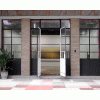 |
James Cohan Gallery, Shanghai
1/F Building 1, No.1 Lane,
170 Yue Yang Road,
Shanghai 200031, PRC CHINA map *
tel: +86 21 5466 0825
fax: +86 21 5466 0823
send email
website
|

Enlarge
|
| Recent Paintings and Watercolors
|
|
| by James Cohan Gallery, Shanghai
Location: James Cohan Gallery Shanghai
Artist(s): GUO Hongwei, Yuko MURATA, Karen SEAPKER
Date: 17 Nov 2010 - 28 Jan 2011
James Cohan Gallery Shanghai is pleased to present an exhibition of three young emerging painters, Guo Hongwei from mainland China, Yuko Murata from Japan, and Karen Seapker from the United States. All three artists, having already attained a certain prominence and international following, will be exhibited together for the first time in Shanghai. An informal link connecting the works by these artists for this exhibition is the theme of natural history and the natural world.
Guo Hongwei’s new oil paintings and watercolors examine the idea of the natural history museum and the role of science. His new works feature images of the moon, fire, skulls, birds, animal specimens, fossils, and plant life. Guo is well known for his unique painting techniques, using water to wash the images to achieve delicate watery traces on paper. For his paintings his use of excessive oil and varnish lends his deadpan objects a mysterious and almost cinematic air. While there is a persuasive conceptual premise that often initiates a new body of work, it is always Guo’s desire to remain experimental, more open to the working process, “more introspective—into texture and methodology—as opposed to ideology.” By visually cataloguing the objects or subjects he chooses to paint, a pictorial structuring device the artist frequently employs, it allows for a closely studied repetition in which to paint something but to paint it differently each time. The iconic images in many of these new works could be seen as auspicious symbols in Chinese culture, such as the moon or fire paintings, but they also touch upon the universal fascination with images and subjects as old as mankind itself.
For the past decade Yuko Murata’s paintings have depicted animals and the landscape. The sources for her images are based on found photographs from tourist brochures, postcards, zoo guidebooks and wildlife magazines. Much of this secondary source material is then pared down to their essential elements, and the resulting paintings feature fragmented versions of these images. Animals such as rodents, rabbits, squirrels, hamsters, bats, birds, horses, monkeys, and parrots are portrayed in solitary portrait style. Whether gazing at the viewer directly or focused on a fixed point outside of the painting, seemingly aloof and unknowable, the viewer has no way of knowing what the animal is seeing. Like Guo Hongwei, Murata is intensely involved with the painting process—the viscosity of oil paint, brushstrokes, surface variation—as a means to emphasize the unnatural characteristics of her chosen images. To date her paintings have rarely been larger than 40 x 30 centimeters, (12 x 15 inches) suggesting a contemplative connection between the intimacy and scale of her source material and experience for the artist and viewer. Murata has commented on the evident ‘cuteness’ of her animal paintings, to which she’s replied, “For people who look at my pictures and think, “Oh, how cute,” I want to say, “You are being fooled by my animals.” As in Murata’s landscapes these modest compositions defy their idyllic innocence and have been said to be influenced by 18th century Japanese paintings, when artists were challenged to create works with a minimum of colors or objects. For Murata it is all about the journey, an ongoing search for “a place that does not exist.”
In Karen Seapker’s paintings one feels the world at high speed. Surges of color combined with sweeping brushwork activate and accelerate this sense of movement. Predominantly abstract and relatively modest in scale, Seapker’s paintings are no less dynamic. There is a balanced authority over their surfaces, but where at any given moment disorder and recklessness could prevail. Other recent observations or comments about Seapker’s work have compared her paintings to windswept landscapes, or cresting waves cascading forcefully across the surface in which to guide the color to its inevitable direction. Titles such as Slip, Almost Where and Rear View provide a bit of stable ground while shrewdly suggesting that we are only passing through and where nothing in this world ever stays still for very long. |
|
|
|
|
